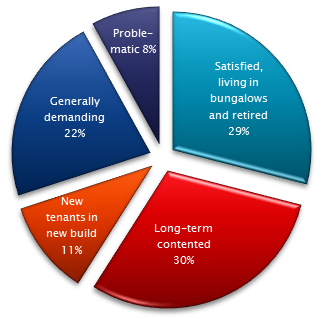Customer segmentation uses data from satisfaction surveys and elsewhere to drive service improvement and increase satisfaction. It works by segmenting your resident population into relatively homogeneous groups that can be measured, analysed, and targeted. It is a simple idea, backed up by rather less-simple statistical analysis, which can be highly effective.
It begins with a consideration of the following:
- Do you know who your residents are?
- Do you know the characteristics of your residents?
- Do you know what influences your residents when rating satisfaction with their landlord?
- Do you know who amongst your residents are the easiest to please and those who are a drag on your resources?
The challenge
The majority of landlords have well-developed housing management systems and should have information on service use in different areas – repairs, rent arrears, complaints, customer services, tenant engagement – which is needed for customer segmentation. Segmentation analysis will help landlords gain greater understanding, however the harder part may well be for the landlords themselves in terms of using the information internally to drive through behaviour and service changes for targeted customer groups.
The process
In order to explore the basis for segmenting residents, a mix of data sources is used – STAR survey data and internal housing management data to determine the factors used in the modelling process. A statistical analysis (k-means cluster analysis) is used to identify the segments of residents, clustering on a small number of key variables / factors to identify the “best” solution. Once the final segmentation is identified, portraits of each segment are produced.
What one landlord found
Satisfied retired residents living in bungalows – This group are generally very satisfied with services and the area they live in. They have low levels of arrears, and require a high number of repairs. The biggest issue facing these tenants is often their poor health, and accessibility by public transport may also be an issue. They care about being informed and the neighbourhood’s safety and security. This tells us that this group may be isolated and need reassurance about security. Communication via traditional methods, like a housing officer calling around to discuss neighbourhood issues, will most likely improve our service to them. A handyman service could also help with the high number of repairs.
Long-term contented – This group of mainly families and couples stay in their properties a long time, have a low number of repairs and yet higher than average repair costs. They are more dissatisfied than most with their home and with us, and are financially very stretched, often struggling to pay loans and credit cards. Digitally, they are the most connected segment with high computer and mobile use. This tells us that offering debt advice and other services online and via email may be the best way to improve our service to them.
New tenants in new build – This group is comprised of young tenants with high incomes, many of whom live in newly-built flats. They like where they live and are likely to recommend the organisation. Reporting a high number of repairs they rate the repairs service lower than other residents and are less satisfied with the value for money of the rent. The group have the highest number of Smartphones. This tells us that we need to engage with this group online and via text to improve our repairs service to them.
Generally demanding – Many of the households in this group are families or couples with a high number in rent arrears, often living in houses. They make high demands on customer services and report the highest number of repairs. A high number of residents in this group use the internet. This tells us that offering debt advice and communication online and via email may be the best way to improve our service to them.
The problematic – This group are generally not very happy with the repairs service, estate services and any communal areas. When they contact the organisation they do not rate staff highly and tend to be unhappy with any advice or support given. As a group they report a high number of repairs, neighbourhood nuisance/ASB and complaints. This group are more likely to have arrears and high repairs costs. Residents in this group are more likely to health problems, have been tenants for over ten years and a high percentage are in receipt of full housing benefit. This tells us that we need to ensure that our general communications and repairs systems are clear and we do not create mismatched expectations.







Comments are closed.